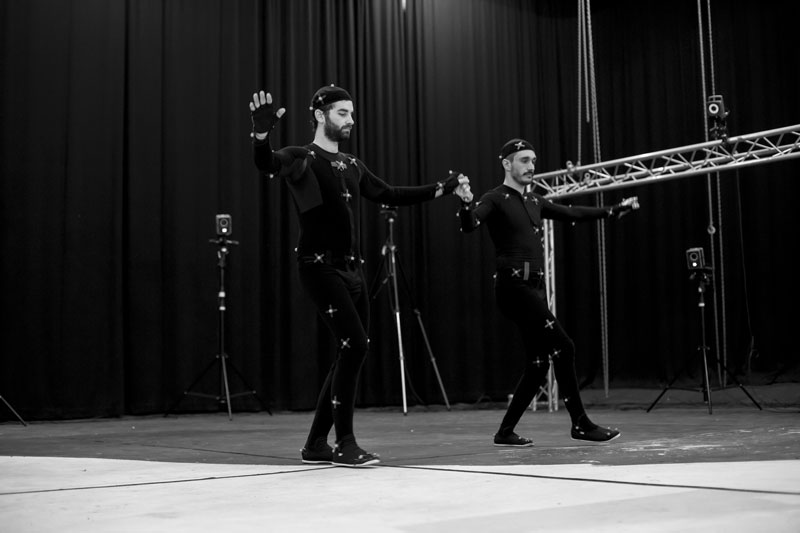by Katerina El Raheb and Yannis Ioannidis (“Athena” Research and Innovation Center and National and Kapodistrian University of Athens)
WhoLoDancE (Whole-body Interaction Learning for Dance Education), a three-year EU funded project, has developed innovative technologies for dance practice, creation and education, focusing on four dance genres: ballet, contemporary, flamenco, and Greek folk.
The relationship between dance education and new technologies is still immature, but evolution in fields such as motion capture, augmented, mixed and virtual reality, combined with data, information and knowledge representation and analysis, have great potential to benefit the dance education of the future [1].
The WhoLoDancE (Whole-body Interaction Learning for Dance Education) project’s main goal is to design and apply innovative digital education technologies that will benefit the community of dance practitioners, experts, researchers, students, educators, choreographers, as well as the wider community of amateurs and professionals and the interested public.

Figure 1: Two Greek Folk dancers from Lykeion ton Hellinidon (The Lyceum Club of Greek Women) recorded using optical Motion Capture at Motek Entertainment Studio, for the creation of WhoLoDancE Movement Library.
The project’s objectives can be summarised as: (i) to investigate bodily knowledge by applying technologies such as computational models to automatically extract characteristics that are relevant to both the quantitative and expressive characteristic of movement; (ii) to preserve cultural heritage by creating a motion capture repository of dance motions, with built-in methods allowing enrichment through annotation, segmentation and synthesis, (iii) to develop innovative ways of teaching dance, such as via life-sized visualisation of the body through different avatars in mixed reality - e.g., using HoloLens and sonification of movement; (iv) to revolutionise choreography, by designing and organising an interactive repository of motion capture, providing choreographers and dance teachers a powerful tool to blend and get inspired by an infinite number of dance compositions from different dance traditions; (v) to extend access to and practice of dance, by providing access to the created dance database through commercially available low-end motion capture devices like the MS Kinect, low-cost sensors and wearables.
The project focused on four dance genres that represent different forms of intangible heritage and / or performing art: ballet, contemporary, flamenco and Greek folk. Each of these genres also presents unique requirements related to movement vocabulary and teaching approach.
A major outcome of the project is the creation of a big database of over 780 curated dance movement sequences that have been recorded using motion capture technologies. A conceptual framework [2] has been proposed to guide the recording process and develop the user scenarios and requirements for the final whole-body interaction experiences. The resulting toolkit of WhoLoDancE includes a set of web-based tools to analyse, segment, annotate and blend movement as well as interactive experiences that integrate augmented and mixed reality, sonification of movement and visualisation of the human body and movement in different avatars and environments [3]. In addition, several evaluation events and performative workshops have been held throughout Europe (UK, Greece, Italy, Spain) targeting dance educational institutions and wider audience.
WhoLoDancE project, as a collaboration between technology experts, researchers, dance educators, choreographers and artists, used four dance genres as use-cases and a proof-of-concept to open a dialogue on how dance movement can be captured and transmitted to the next generations. In fact, both the outcomes and open issues that have been reported by the project, suggest that there is still considerable future work to be done to design the ideal digital educational experience for dance. The process is complicated by the complexity and richness of human movement as well as the diversity and cultural pluralism that is integrated into dance. For example, teaching of Greek folk dance, as a traditional dance form and an important part of cultural heritage, includes much more than the teaching of the movement itself. Every dance is tightly connected with rhythm, lyrics, the location of its origin, the customs, the climate, the costume, the context in which the particular dance is performed and by whom (e.g., elders, men, women), the stories and traditions.
There are huge technical challenges associated with analysing movement, and to address it properly requires a collaborative effort between multiple computer science fields, including motion capture, signal processing, data analytics, semantic technologies, artificial intelligence, human computer interaction, graphics and digital artistic perspectives. The interdisciplinary challenges have proven even greater, and in most cases the design process of a meaningful digital pedagogical tool is a complex constraint satisfaction problem, with conflicting objectives (e.g., making tools that are reusable and scalable vs. identifying and respecting the needs of the particular dance traditions).
Upon completion of the project, most of the partners, including “Athena” Research and Innovation team will be continuing research into how to make relevant technologies more usable, cost-effective and accessible to a wider audience. As a research team, we will keep investigating effective and meaningful ways to document, represent and transmit dance movement and knowledge.
WhoLoDancE (Whole-body Interaction Learning for Dance Education) is a closed three-year Research and Innovation Action funded under the European Union’s Horizon 2020 Programme that investigates the design and application of digital tools to dance learning and education [L1]. WhoLoDancE is a collaboration between European technology research, educational and intangible cultural heritage institutions with creative industry and dance companies.
Link:
[L1] http://www.wholodance.eu/
References:
[1] K. El Raheb, et al.: “Dance Interactive Learning Systems: A Study on Interaction Workflow and Teaching Approaches”, ACM Computing Surveys (CSUR) 52.3 (2019): 50.
[2] A. Camurri, et al.: “WhoLoDancE: towards a methodology for selecting motion capture data across different dance learning practice”, in Proc.of the 3rd International Symposium on Movement and Computing. ACM, 2016.
[3] A. Rizzo, et al.: “WhoLoDancE: Whole-body Interaction Learning for Dance Education”, CIRA@ EuroMed. 2018.
Please contact:
Katerina El Raheb,
National and Kapodistrian University of Athens, Greece,











